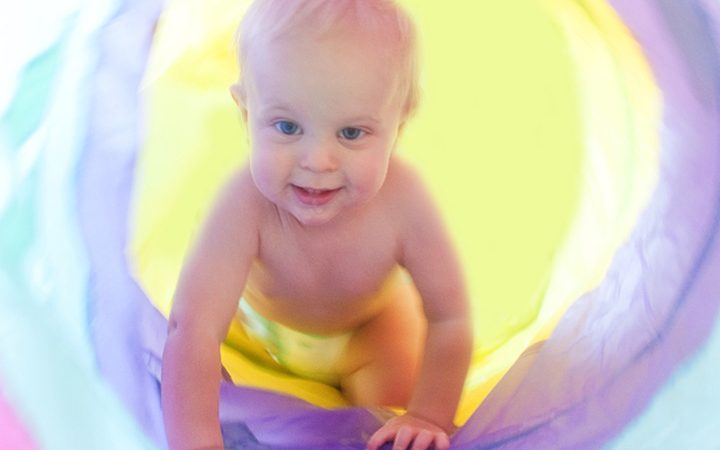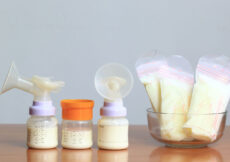Motor skills are majorly divided into gross motor and fine motor skills. Gross motor skills require the movement of most strongest and largest core muscles of the body, such as legs, torso, arms, etc (1). Research shows that increased gross motor activities for infants are associated with better cognitive abilities and increased physical activity, leading to lower BMI and better cardiorespiratory fitness (2). WHO guidelines suggest, infants should be engaged in gross motor activities for several hours a day, especially through interactive floor play to improve their motor skills (3).
Read this post for some fun activities that you can perform with your infant to help them with their gross motor skill development.
Gross Motor Skills In Infants
Some activities that help develop gross motor abilities in infants are (4):
For infants, the scope of physical activities is limited. However, they might cross new developmental milestones according to their growth rate with each passing day. Some of the general developmental milestones based on gross motor skills for infants are (5):
- Being able to stand without any support for a brief period
- Pulling things for support while standing up
- Sitting without support
- Taking small steps
- Reaching for their toes
12 Gross Motor Activities For Infants
1. Having tummy time
Tummy time is when you place your infant on their tummy on a play mat. Having tummy time is important for infants because it (6):
- Strengthens the shoulder and neck muscles
- Enhances motor skills as the baby needs to utilize muscles and strength to move or lift their head
- Helps prevent flat spots at the backside of baby’s head
2. Rolling a ball
Take a ball that your little one may enjoy playing with. Make them sit with the help of support, and you sit across them. Now roll the ball towards them and let them try to get a hold of it. Do this a few times, and then let them do the same and roll the ball towards you and explore their ball skills. You can also do this activity with the help of an exercise ball.
This activity will help enhance the muscle strength of the lower body as they sit, move from one place to another, and improve their hand-eye coordination.
3. Playing with blocks
Blocks are a favorite for every infant. They make them move from one place to another. Build a tower with blocks a little far away from the reach of your infant and encourage them to crawl towards it. You can also keep one or two blocks closer to your baby to help them and encourage the process.
4. Allowing free movement
Infants are sensitive to be left alone in an open area. However, it is also important for them to freely move their hands and legs to develop and increase their body awareness.
Put your baby on a play mat and let them entertain themselves. You should supervise them at all times.
5. Having a toy bin treasure hunt
When your little one is beginning to sit up, with or without support, you should keep them entertained and enthusiastic. Make a toy bin for them to stay engaged.
Take a basket and put all their toys into it. Then place this basket by their side and let them explore. Going through the basket and playing with different toys will help develop their sensory skills.
6. Playing with sensory bags
You can make DIY sensory bags for your baby to play with during tummy time or while they are laying awake on their mat, to keep them engaged.
To make a sensory bag, you will need:
- A transparent zip-lock bag
- Water
- Buttons and beads (you can use other things such as pom poms)
Take the zip lock bag and put the beads and buttons inside it. Then fill it with water and seal it properly so that the stuff inside will not leak out when pressure is applied. You can give this bag to your baby during their tummy time to keep them engaged. This activity may help enhance the sensory skills eye-hand coordination skills of your baby.
7. Painting
Who doesn’t love playing with colors? Grab a medium-sized chart paper and some colors (it can either be plastic colors or watercolors). Place them in front of your child and let them create masterpieces with some splish here and there. Art projects may help them move their hand muscles over a wide range of areas and develop their motor skills. Also, remember to keep them under continuous supervision to avoid choking hazards.
8. Kicking a balloon /a ball
This is another activity that helps strengthen the leg muscles of your baby. Place your baby on a play mat and attach balloons or a ball surrounding the mat. Kicking and playing with the balloon or ball can keep them occupied and helps improve their physical development.
9. Pulling a stuffed pet
For infants who have just started to walk, this can be a fun activity. Tie a ribbon or a lace around the neck of a stuffed dog or a cat and give it to your infant. They will have fun pulling it around. You can also model this activity by doing the same with another toy for them to watch and learn.
10. Climbing a box
Climbing boxes can help develop the muscles of the hands and legs. Take an empty cardboard box and fill it with random things to make it heavy so it does not tumble over while being pushed. Tape the mouth of the cardboard and decorate it with colors or colored paper to make it attractive. Now your infant can either push it or use it as a support to stand or sit on it.
11. Crossing tunnels
Introducing your infant to tunnels can be exciting. Place a blanket in between two chairs and make a tunnel. Then, sit on the other side of the tunnel opposite to your baby and encourage them to come towards you through the tunnel. You may also take the help of toys to attract them and cross the tunnel.
12. Playing on a texture mat
Introducing different textures to your infant can help develop their sensory skills. Take a play mat and place various toys of different textures. Now let your infant crawl around the mat and discover various textures, shapes and enjoy themselves.
Developing motor skills is a vital part of baby development. Engaging them in everyday activities, such as painting and playing with blocks, can help them have well-developed gross motor skills. However, the growth rate of each child is different from the other. So, if your child takes more time to develop gross motor skills, do not worry, as they may eventually learn and grow at their pace.
References:
MomJunction’s articles are written after analyzing the research works of expert authors and institutions. Our references consist of resources established by authorities in their respective fields. You can learn more about the authenticity of the information we present in our editorial policy.
The following two tabs change content below.




































